Adaptive Cruise Control (ACC) And Blind Spot Detection (BSD) Market Size
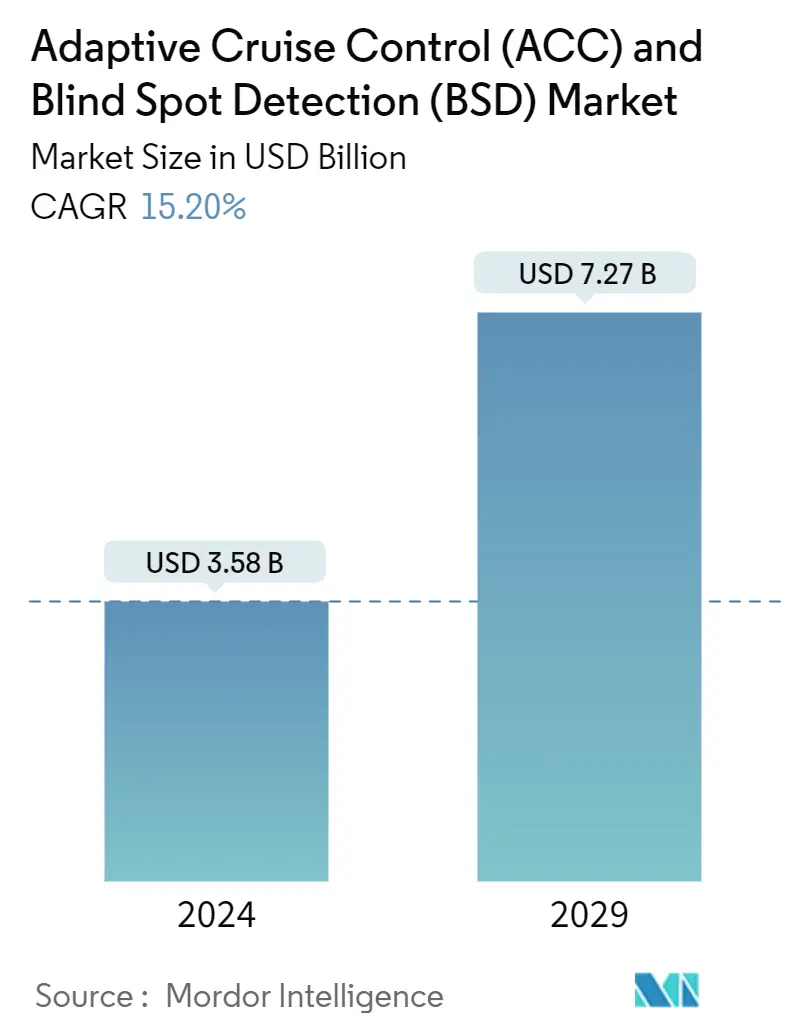
| Study Period | 2019 - 2029 |
| Market Size (2024) | USD 3.58 Billion |
| Market Size (2029) | USD 7.27 Billion |
| CAGR (2024 - 2029) | 15.20 % |
| Fastest Growing Market | Asia Pacific |
| Largest Market | Europe |
Major Players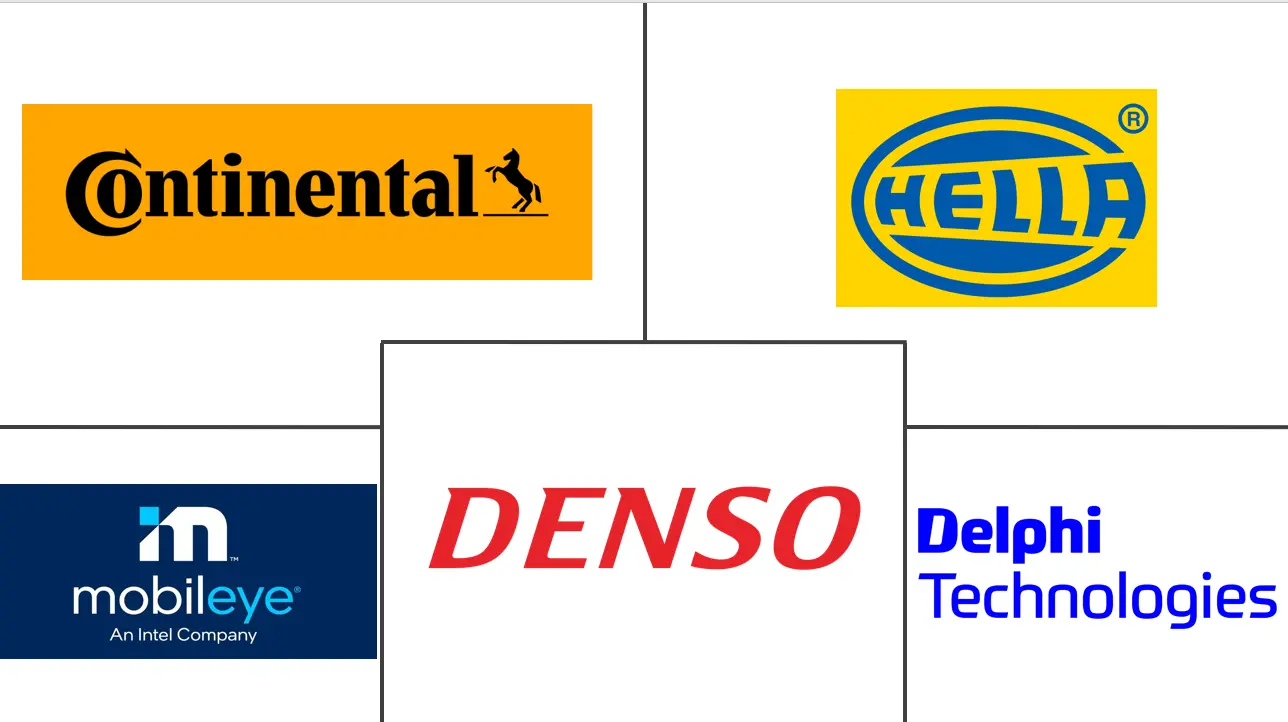
*Disclaimer: Major Players sorted in no particular order |
Need a report that reflects how COVID-19 has impacted this market and its growth?
Adaptive Cruise Control (ACC) And Blind Spot Detection (BSD) Market Analysis
The Adaptive Cruise Control And Blind Spot Detection Market size is estimated at USD 3.58 billion in 2024, and is expected to reach USD 7.27 billion by 2029, growing at a CAGR of 15.20% during the forecast period (2024-2029).
The market for adaptive cruise control and blind spot detection has witnessed a significant surge in recent years. The growing awareness about vehicle safety has been one of the vital factors in the development of advanced safety systems, such as adaptive cruise control and blind-spot detection.
Additionally, the increase in the sales of luxury vehicles worldwide is also driving the market for ACC and BSD. In 2023, over 183 thousand units of luxury cars were sold worldwide, compared to 157 thousand units in 2022. This indicated a significant surge of over 16%.
Further, the enactment of stringent safety regulations and increasing vehicle safety concerns among consumers have also propelled the market for ACC and BSD. According to the World Health Organization, nearly 1.35 million people die annually due to road accidents. The cause of these accidents is mostly attributed to the driver's inability to judge certain conditions and make the right decisions. The efforts of governments to reduce fatalities due to road accidents have led to increased installation of safety systems in new vehicles.
More than 90% of the market studied is captured by OEMs, with a limited and unorganized aftermarket for the blind spot detection system. Eyeing the growth opportunities present in the market, the leading players are increasingly incorporating these features in their vehicles to cater to consumer demand.
All these factors combined indicate potential growth for the ACC and BSD market during the forecast period.
Adaptive Cruise Control (ACC) And Blind Spot Detection (BSD) Market Trends
Passenger Car Segment is The Largest Vehicle Type Segment
The passenger car segment is the largest market segment for adaptive cruise control (ACC) and blind spot detection (BSD) among vehicle types. There has been a widespread integration of advanced driver assistance systems (ADAS) in modern passenger cars, driven by a growing emphasis on safety and the increasing consumer demand for enhanced driving experiences.
Passenger car manufacturers are largely offering cutting-edge features that enhance both safety and convenience. ACC systems are well-suited for highway driving, making them particularly attractive for daily commuters and long-distance travelers using passenger cars. The mainstream adoption of ACC in passenger cars is fuelled by advancements in sensor technologies, affordability, and a shift toward semi-autonomous driving features.
Similarly, blind spot detection has also become a crucial safety feature, especially in urban environments with dense traffic. The passenger car segment, being the largest volume contributor in the automotive market, experiences a higher incidence of lane changes and merging movements. BSD addresses the limitations of driver visibility by using sensors to detect vehicles in blind spots, reducing the risk of accidents during lane changes—a common scenario in passenger car usage.
Furthermore, regulatory initiatives and safety ratings that prioritize vehicles equipped with advanced safety features contribute to the prevalence of ACC and BSD in passenger cars. In North America, the United States New Car Assessment Program (US NCAP), a flagship program of the country's National High Traffic Safety Administration (NHTSA), focused on the incorporation of these safety systems, was introduced to reduce the safety-related concerns of buyers.
Automakers are integrating these technologies into their passenger car models, making them more appealing to a broader customer base. Market players have multiple active patents registered to their name related to autonomous features in their vehicles. In 2022, Toyota had the most number of active patents, amounting to 1,823, followed by Baidu and Honda Motors.
Apart from passenger cars, commercial vehicles, particularly large trucks, are also seeing an increase in demand for sophisticated driver assistance systems and collision avoidance systems. Commercial vehicles are longer and broader than passenger vehicles, resulting in substantially greater blind areas. Thus, to enhance safety and eliminate blind spots, companies, in consultation with commercial vehicle manufacturers, are developing blind spot detection systems that are suitable for these vehicles.
The rising vehicle safety concerns and a growing number of blind spot-related accidents are some of the factors that will drive the market for ACC and BSD systems during the forecast period.
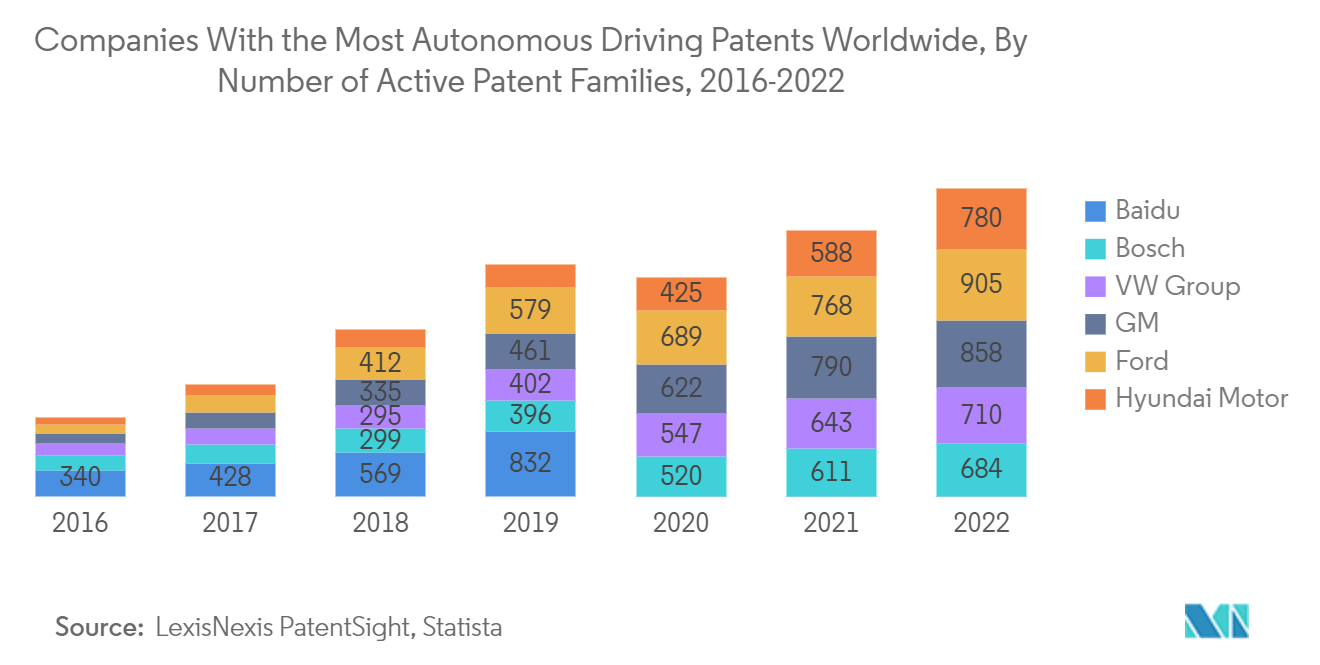
Asia-Pacific and North America Driving the Market
Asia-Pacific is projected to be the fastest-growing regional market, contributing significantly to the growth of both the BSD and ACC industries, followed by North America. The growth in these regions is driven by factors such as increasing vehicle sales, particularly of luxury cars, and an increase in safety installations per vehicle.
The presence of fast-developing countries, like India and South Korea, and the safety regulations imposed on vehicles in the region have influenced the Asia-Pacific market for driving assistance systems significantly. These regulations are as stringent as those of Europe and North America.
- The Bharat New Car Assessment Program, commonly known as Bharat NCAP, is the 10th NCAP in the world and has been set up by the Government of India. The program commenced in October 2023. The program aims to evaluate the safety performance of cars sold in India and assign star ratings based on their safety features and performance. Bharat NCAP will assign star ratings ranging from 1 to 5 for cars tested, with 1 being the lowest rating. These ratings cover Adult Occupant Protection (AOP), Child Occupant Protection (COP), and Fitment of Safety Assist Technologies.
Additionally, the improvement in socioeconomic conditions in India, Thailand, and Indonesia has also created a demand for the premium passenger cars segment, thereby increasing the demand for ACC and BSD in these countries.
Further, the rising awareness of driver safety systems is enhancing the market for ADAS-equipped vehicles in Asia-Pacific countries. Government regulations are compelling car manufacturers to design their vehicles with advanced ADAS modules. Moreover, the evolution of autonomous cars in this region is creating the opportunity for tier-1 manufacturers to design and deliver ADAS with the latest technologies and user-friendly systems.
All these developments combined are expected to drive the market for adaptive cruise control (ACC) and blind spot detection (BSD) in Asia-Pacific.
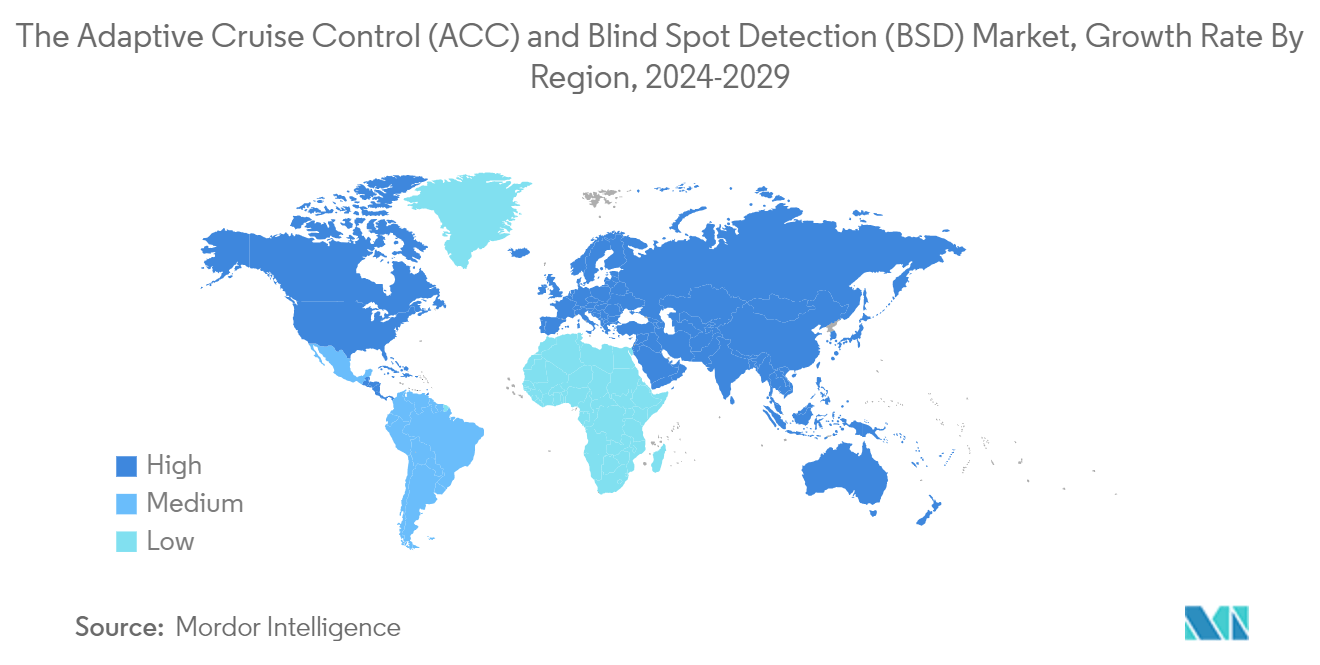
Adaptive Cruise Control (ACC) And Blind Spot Detection (BSD) Industry Overview
The adaptive cruise control (ACC) and blind spot detection (BSD) market is fairly consolidated. Companies such as Continental AG, Hella KGaA Hueck & Co., Mobileye, Denso Corporation, and Delphi Automotive PLC are some of the major players in the market.
To meet the increasing standards for safety features in the vehicles, major ACC and BSD manufacturers in the market have started investing in R&D activities. For instance,
• In July 2023, Mitsubishi Motors Corporation premiered the completely redesigned Triton 1-ton pickup truck in Bangkok, Thailand. The truck company scheduled a launch in Japan in early 2024 for the first time in 12 years. Safety and comfort have been greatly improved in the vehicle with the adoption of Adaptive Cruise Control (ACC), among other new safety features and emergency support using connected car technology.
Adaptive Cruise Control (ACC) And Blind Spot Detection (BSD) Market Leaders
Continental AG
Hella KGaA Hueck & Co.
Delphi Technologies PLC
DENSO Corp
Mobileye
*Disclaimer: Major Players sorted in no particular order
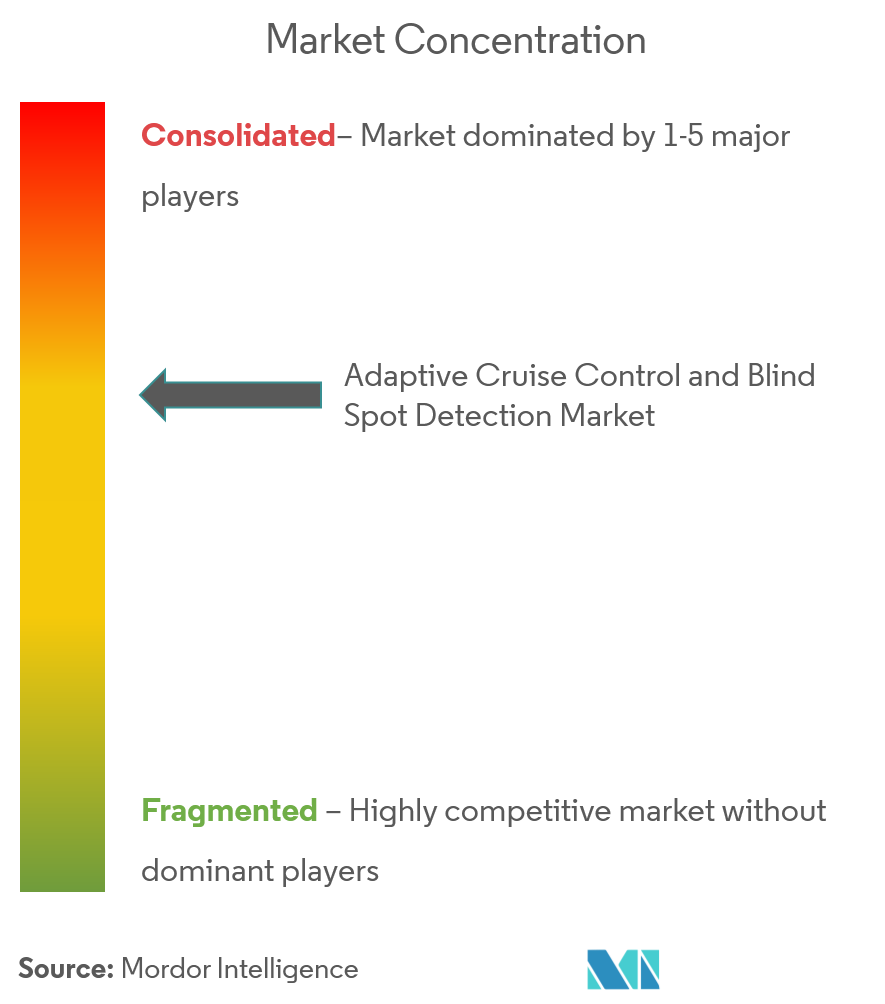
Adaptive Cruise Control (ACC) And Blind Spot Detection (BSD) Market News
- November 2023: ECARX Holdings Inc. announced a new series of ADAS-enabled products, starting with the ECARX Skyland Pro. It will support drivers as the autonomy of their vehicles increases. The ECARX Skyland Pro platform supports industry-leading bird's-eye view (BEV) perception algorithms and a 5R10V sensor configuration. ECARX Skyland Pro also boasts automatic emergency braking (AEB), lane-keeping assist (LKA), lane departure warning (LDW), blind spot detection (BSD), and electronic stability control (ESC).
- September 2023: BMW announced the release of the new BMW R 1300 GS- Next level GS featuring a new boxer engine and new suspension, with significantly reduced weight and increased GS competence all round. The new BMW R 1300 GS features the new riding assistant option, consisting of components including active cruise control (ACC), front collision warning (FCW), and lane change warning (SWW).
- February 2023: NXP Semiconductors released the latest member of its scalable S32R radar processor family, the S32R41, into production. CubTEK, an ADAS total solution expert, will leverage NXP’s S32R41 processors and TEF82xx RFCMOS transceivers for its new high-end radar sensor system. CubTEK’s ECE R151 certified system fulfills the BSD, LCA, and TA functions, solving the tractor and container angle issues.
Adaptive Cruise Control (ACC) And Blind Spot Detection (BSD) Market Report - Table of Contents
1. INTRODUCTION
1.1 Study Assumptions
1.2 Scope of the Study
2. RESEARCH METHODOLOGY
3. EXECUTIVE SUMMARY
4. MARKET DYNAMICS
4.1 Market Drivers
4.1.1 The Increasing Concern of Consumers Toward Vehicle Safety is Driving the Market
4.2 Market Restraints
4.2.1 High Initial Installation Costs of ACC and BSD Act as a Major Challenge
4.3 Industry Attractiveness - Porter's Five Forces' Analysis
4.3.1 Threat of New Entrants
4.3.2 Bargaining Power of Buyers/Consumers
4.3.3 Bargaining Power of Suppliers
4.3.4 Threat of Substitute Products
4.3.5 Intensity of Competitive Rivalry
5. MARKET SEGMENTATION (Value in USD Billion)
5.1 Type
5.1.1 Adaptive Cruise Control (ACC)
5.1.2 Blind Spot Detection (BSD)
5.2 Vehicle Type
5.2.1 Passenger Cars
5.2.2 Commercial Vehicles
5.3 Sales Channel
5.3.1 OEM
5.3.2 Aftermarket
5.4 Technology
5.4.1 Infrared
5.4.2 Radar
5.4.3 Image
5.4.4 Other Technologies
5.5 Geography
5.5.1 North America
5.5.1.1 United States
5.5.1.2 Canada
5.5.1.3 Mexico
5.5.1.4 Rest of North America
5.5.2 Europe
5.5.2.1 Germany
5.5.2.2 United Kingdom
5.5.2.3 France
5.5.2.4 Spain
5.5.2.5 Rest of Europe
5.5.3 Asia-Pacific
5.5.3.1 China
5.5.3.2 Japan
5.5.3.3 India
5.5.3.4 South Korea
5.5.3.5 Rest of Asia-Pacific
5.5.4 Rest of the World
5.5.4.1 Brazil
5.5.4.2 Argentina
5.5.4.3 Other Countries
6. COMPETITIVE LANDSCAPE
6.1 Vendor Market Share
6.2 Company Profiles*
6.2.1 Continental AG
6.2.2 Delphi Technologies PLC
6.2.3 DENSO Corp
6.2.4 Autoliv Inc.
6.2.5 Magna International
6.2.6 WABCO Vehicle Control Services
6.2.7 Robert Bosch GmbH
6.2.8 ZF Friedrichshafen AG
6.2.9 Bendix Commercial Vehicle Systems LLC (Knorr-Bremse AG)
6.2.10 Mobileye
6.2.11 Mando-Hella Electronics Corp.
7. MARKET OPPORTUNITIES AND FUTURE TRENDS
7.1 Increasing Use of ADAS Features in Vehicles Presents Ample Growth Opportunities
8. MARKET SIZE AND FORECAST IN TERMS OF VOLUME
9. ANALYSIS OF THE TECHNOLOGICAL ADVANCEMENTS IN ACC AND BSD TECHNOLOGIES
10. INSIGHT INTO THE REGULATORY MANDATES FOR VEHICLE SAFETY AND ADAS FEATURE INCORPORATION ON REGIONAL/COUNTRY LEVEL
Adaptive Cruise Control (ACC) And Blind Spot Detection (BSD) Industry Segmentation
Adaptive cruise control (ACC) is an advanced driver assistance system that automatically adjusts a vehicle's speed to maintain a safe following distance from the vehicle ahead. Blind spot detection (BSD) is a safety feature that uses sensors, cameras, or radar to monitor the areas around a vehicle that may not be visible to the driver.
The Adaptive cruise control (ACC) and blind spot detection (BSD) market is segmented by type, vehicle type, sales channel, technology, and geography. By type, the market is segmented into adaptive cruise control and blind spot detection. By vehicle type, the market is segmented into passenger cars and commercial vehicles. By sales channel, the market is segmented into OEM and aftermarket. By technology, the market is segmented into infrared, radar, image, and other technologies. By geography, the market is segmented into North America, Europe, Asia-Pacific, and the Rest of the World. The report also provides market sizing and forecasts for all the abovementioned segments in value (USD).
| Type | |
| Adaptive Cruise Control (ACC) | |
| Blind Spot Detection (BSD) |
| Vehicle Type | |
| Passenger Cars | |
| Commercial Vehicles |
| Sales Channel | |
| OEM | |
| Aftermarket |
| Technology | |
| Infrared | |
| Radar | |
| Image | |
| Other Technologies |
| Geography | |||||||
| |||||||
| |||||||
| |||||||
|
Adaptive Cruise Control (ACC) And Blind Spot Detection (BSD) Market Research FAQs
How big is the Adaptive Cruise Control And Blind Spot Detection Market?
The Adaptive Cruise Control And Blind Spot Detection Market size is expected to reach USD 3.58 billion in 2024 and grow at a CAGR of 15.20% to reach USD 7.27 billion by 2029.
What is the current Adaptive Cruise Control And Blind Spot Detection Market size?
In 2024, the Adaptive Cruise Control And Blind Spot Detection Market size is expected to reach USD 3.58 billion.
Who are the key players in Adaptive Cruise Control And Blind Spot Detection Market?
Continental AG, Hella KGaA Hueck & Co., Delphi Technologies PLC, DENSO Corp and Mobileye are the major companies operating in the Adaptive Cruise Control And Blind Spot Detection Market.
Which is the fastest growing region in Adaptive Cruise Control And Blind Spot Detection Market?
Asia Pacific is estimated to grow at the highest CAGR over the forecast period (2024-2029).
Which region has the biggest share in Adaptive Cruise Control And Blind Spot Detection Market?
In 2024, the Europe accounts for the largest market share in Adaptive Cruise Control And Blind Spot Detection Market.
What years does this Adaptive Cruise Control And Blind Spot Detection Market cover, and what was the market size in 2023?
In 2023, the Adaptive Cruise Control And Blind Spot Detection Market size was estimated at USD 3.04 billion. The report covers the Adaptive Cruise Control And Blind Spot Detection Market historical market size for years: 2019, 2020, 2021, 2022 and 2023. The report also forecasts the Adaptive Cruise Control And Blind Spot Detection Market size for years: 2024, 2025, 2026, 2027, 2028 and 2029.
Adaptive Cruise Control (ACC) And Blind Spot Detection (BSD) Industry Report
Statistics for the 2024 Adaptive Cruise Control (ACC) And Blind Spot Detection (BSD) market share, size and revenue growth rate, created by Mordor Intelligence™ Industry Reports. Adaptive Cruise Control (ACC) And Blind Spot Detection (BSD) analysis includes a market forecast outlook to 2029 and historical overview. Get a sample of this industry analysis as a free report PDF download.
